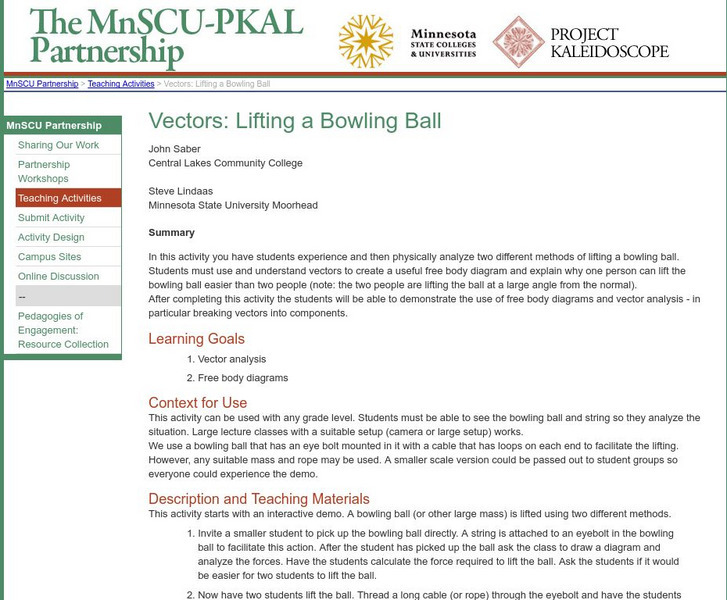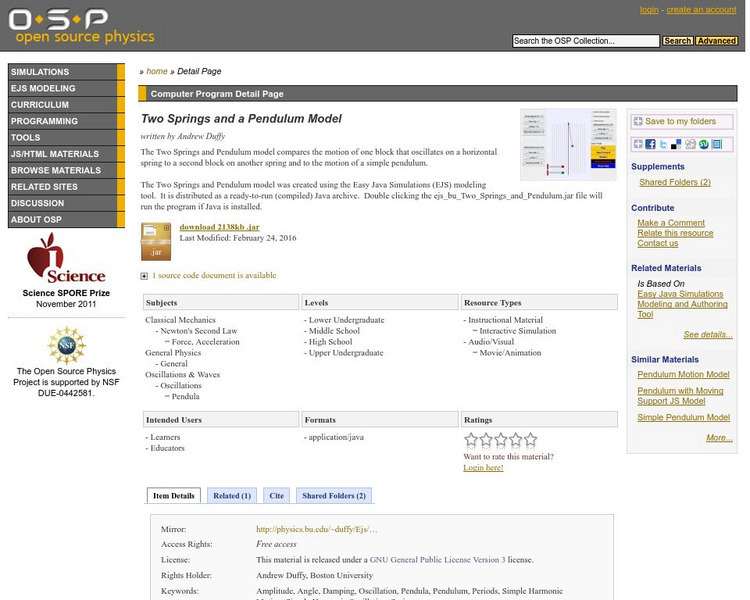Hi, what do you want to do?
Science Education Resource Center at Carleton College
Serc: Investigating Gravity: Predicting Time to Hit the Ground
Learners will drop and shoot horizontally "Nerf" balls from a variety of known heights then record the amount of time it takes for the ball to hit the ground for each trial. They will plot height vs. time data and create a trend line for...
Science Education Resource Center at Carleton College
Serc: Investigating Projectile Motion: Creating a Catapult
This lesson is for 9th grade physical science learners. It begins with an inquiry-based lesson using a projectile motion computer simulation. It culminates with students building a catapult; applying and connecting science knowledge from...
Science Education Resource Center at Carleton College
Serc: Determination of Boyle's Law Through Data Collection
Students develop an understanding of the mathematical relationship between pressure and volume of a gas. Students will practice data collection and graphing skills while also making the connection between force and pressure
Science Education Resource Center at Carleton College
Serc: Newton's Second: Having a Ball With Motion
Students will create a gravity ball launcher to demonstrate their understanding of mass, force, momentum, and motion. The students will use critical thinking, measurement, and observation and analysis of data to make changes and improve...
Science Education Resource Center at Carleton College
Serc: Investigating Inertia
In this investigation, students will perform a simple ordering activity and demonstration to determine what inertia is and recognize how inertia affects objects. They will compare and contrast the masses of objects to predict the...
Science Education Resource Center at Carleton College
Serc: Investigating Motion: What Causes Objects to Move?
Students will have an opportunity to determine what makes everyday objects move. Students will be given objects and asked to make predictions on how far each object will move after they blow on it. Then they will measure the distance and...
Science Education Resource Center at Carleton College
Serc: Investigating Forces: Balloon Car Activity
In this activity, teams of students build a car out of common materials which is then propelled by the release of air out of a balloon and must travel a minimum distance. The activity is then extended to a competition to build the car...
Science Education Resource Center at Carleton College
Serc: Vectors: Lifting a Bowling Ball
Students experience and analyze two different methods of lifting a bowling ball. By using and understanding vectors, they create a useful free body diagram to explain why one person can lift the bowling ball easier than two people
Science Education Resource Center at Carleton College
Serc: Using Your Marbles: Making Energy Work for You
This activity is based on the common experiment of running a marble down a ramp to do work on a cup. Students will be able to see the relationship between mass and energy of the marble and the ramp height.
TryEngineering
Try Engineering: Give Me a Brake
Activity investigates the concept of how bicycle brakes use force and friction to stop or slow mechanical motion. Students work in teams to devise a simple braking system while suggesting improvements to current bicycle brake design.
TryEngineering
Try Engineering: Pulleys and Force
Learners work in teams to learn how pulleys and pulley systems impact everyday life. This activity explores the concept of force and shows how the use of pulleys can greatly reduce required force.
Virginia Commonwealth University
Virginia Commonwealth University: Power Questions
Good use of linking to provide definitions of power along with examples and probing questions. Created by Robert H. Gowdy, physics instructor at VCU.
Wikimedia
Wikipedia: Centripetal Force
Wikipedia's site on centripetal force provides a section explaining the difference between centripetal force and centrifugal force. Includes formulas and hyperlinked terms.
Physics Games
Physics Games: Bubble Quod
You're in a bubble and that pointy thing in each level is your only ticket to freedom. Don't let any obstacles stand in your way!
Project Britain
Primary Homework Help: Forces Quiz
First, read some fast facts about forces, then take a ten-question, multiple-choice quiz. Check to see if your answers are correct after each question.
American Association of Physics Teachers
Com Padre Digital Library: Open Source Physics: Two Springs and a Pendulum Model
Swing virtual pendulums and compare the motion of one oscillating weight on a horizontal spring to a second weight on another spring. Then, compare how these motions differ from the motion of a simple pendulum.
Open Curriculum
Open Curriculum: Newton's Laws in Three Dimensions
Students can use this article to learn about forces and motions in three dimensions.
Open Curriculum
Open Curriculum: The Nonmechanical Universe
Students learn about the fields of force and gravity in this illustrated article.
Other
St. Chris Physics: The Physics of Skydiving
This illustration provides an overview of the scientific process of when a skydiver steps out of a plane.
Other
University of Cambridge: Park World
Help make Park World a safer place by figuring out which ride is unsafe. You can make the park a much more enjoyable environment!
Other
Liberty Online: Locke's Second Treatise on Government: Of Conquest
At this site you can read Chapter XVI, Of Conquest, by John Locke stating that the basis of any government must be the consent of the people, and implying in the writing that war or revolution is often mistaken as consent. (Published in...
Other
Fearof Physics: Videos
Looking for some more explanantion on a topic covered in physics class? This site contains videos that explore some physics concepts. Videos are broken down by topics. Some videos also give examples on how to solve problems.
Other
Glenn Turner: Gyroscope Math Page
The mathematics associated with gyroscopes can be investigated through this interactive page. Users enter critical parameters about gyroscopes and rotational motion descriptors are given.


























